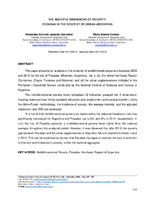| dc.creator | González, Fernando Antonio Ignacio | |
| dc.creator | Santos, María Emma | |
| dc.date.accessioned | 2023-01-02T21:52:54Z | |
| dc.date.available | 2023-01-02T21:52:54Z | |
| dc.date.issued | 2018-02-07 | |
| dc.identifier.citation | González, F. A. I., Santos, M. E. (2018). The multiple dimensions of poverty: Posadas in the context of urban Argentina. Visión de Futuro, Revista Científica. Posadas (Misiones): UNaM. FCE. APP; 22(2), 137-153. | es_AR |
| dc.identifier.issn | 1668 – 8708 | |
| dc.identifier.other | VF-160 | |
| dc.identifier.uri | https://hdl.handle.net/20.500.12219/4067 | |
| dc.description | Fil: González, Fernando Antonio Ignacio. National Research Council Scientific and Technical. Institute of Economic Research and Social Societies of the South; Argentina. | es_AR |
| dc.description | Fil: González, Fernando Antonio Ignacio. National University of the South. Institute of Economic Research and Social Societies of the South; Argentina. | |
| dc.description | Fil: Santos, María Emma. National Research Council Scientific and Technical. Institute of Economic Research and Social Societies of the South; Argentina. | |
| dc.description | Fil: Santos, María Emma. National University of the South. Institute of Economic Research and Social Societies of the South; Argentina. | |
| dc.description.abstract | This paper presents an analysis of the evolution of multidimensional poverty between 2003 and 2015 for the city of Posadas (Misiones, Argentina), vis. a vis. the whole Northeast Region (Corrientes, Chaco, Formosa and Misiones) and all the urban agglomerations included in the Permanent Household Survey, conducted by the National Institute of Statistics and Census of Argentina.
The multidimensional poverty index comprises 12 indicators grouped into 5 dimensions: housing, basic services, living standard, education plus employment and social protection. Using the Alkire-Foster methodology, the incidence of poverty, the average intensity, and the adjusted headcount ratio (M0) are estimated.
It is found that multidimensional poverty as measured by the adjusted headcount ratio has significantly decreased for Argentina and Posadas (up to 8% and 9% in 2015, respectively). In turn, the city of Posadas presents a multidimensional poverty level higher than the national average, throughout the analyzed period. However, it was observed that after 2010, the poverty gap between Posadas and the urban agglomerates of Argentina fell and reached its lowest value in 2015. This can be explained by the fact that Posadas manages to maintain the rate of reduction of intensity and incidence of poverty, unlike the national aggregate. | es_AR |
| dc.format | application/pdf | |
| dc.format.extent | 340 KB | |
| dc.language.iso | eng | es_AR |
| dc.publisher | Universidad Nacional de Misiones. Facultad de Ciencias Económicas. Programa de Posgrado en Administración | es_AR |
| dc.relation | info:eu-repo/semantics/altIdentifier/urn/https://visiondefuturo.fce.unam.edu.ar/index.php/visiondefuturo/article/view/288/95 | |
| dc.relation | info:eu-repo/semantics/altIdentifier/urn/https://visiondefuturo.fce.unam.edu.ar/index.php/visiondefuturo/issue/view/14 | |
| dc.rights | info:eu-repo/semantics/openAccess | |
| dc.subject | Multidimensional poverty | es_AR |
| dc.subject | Posadas | es_AR |
| dc.subject | Northeast region of Argentina | en |
| dc.title | The multiple dimensions of poverty : Posadas in the context of urban Argentina | en |
| dc.type | info:eu-repo/semantics/article | es_AR |
| dc.type | info:ar-repo/semantics/artículo | |
| dc.type | info:eu-repo/semantics/publishedVersion | |



